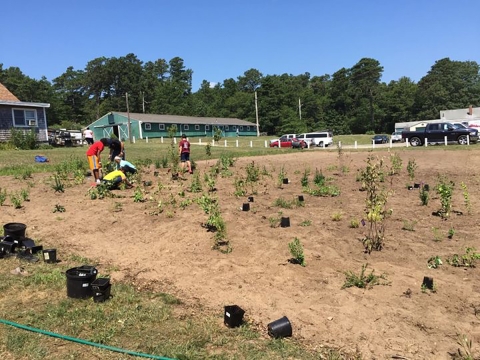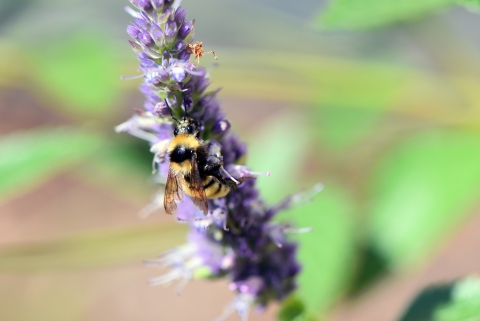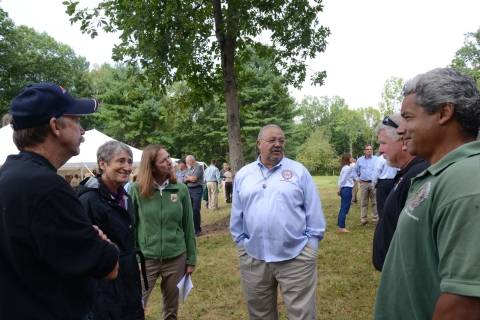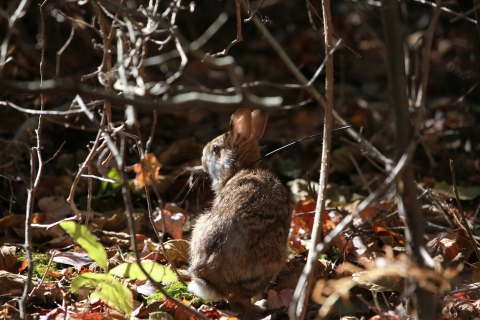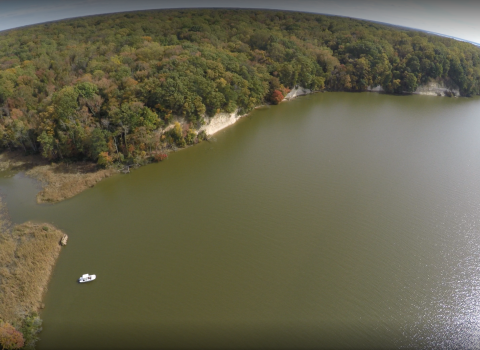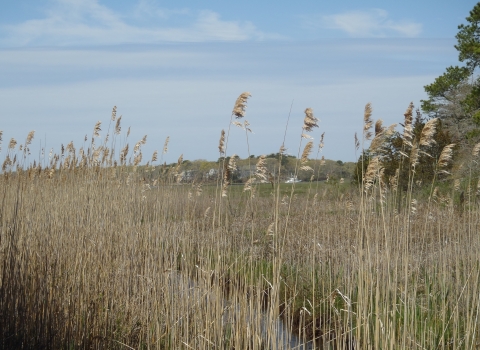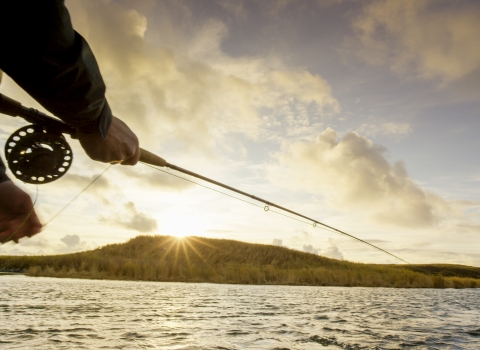As the heat of summer settled on the Mashpee Wampanoag Tribal lands of Cape Cod, Massachusetts, bees zipped between glossy green leaves of sweetgrass grown in the robust habitat of a pollinator garden. Eventually, the vanilla-scented blades were harvested by the Tribe and burned ceremonially on the morning of the 2021 Preserving Our Homelands youth camp planting day.
Each year, the Mashpee Wampanoag Natural Resource Department and Wampanoag Language Reclamation Program join the U.S. Geological Survey and the U.S. Fish and Wildlife Service to host middle-school-aged students for a month-long summer camp, where they learn the cultural and scientific significance of their Tribal land and its natural resources.
This partnership is just one example of how, across the country, the Service is recognizing the value of Tribal collaboration for the benefit of both people and wildlife.
Science and spirituality
For the past 11 years, Service staff at Mashpee National Wildlife Refuge and volunteers from the Friends of Mashpee National Wildlife Refuge have worked closely with the Mashpee Wampanoag Natural Resource Department to plan, plant and manage a series of pollinator gardens during the Preserving Our Homelands summer camp.
Together, they determine what species to plant and where to plant them. By growing a mixture of native medicinal, ceremonial and edible plants, these projects benefit pollinators while supporting the cultural practices of the Tribe.
In 2021, the Tribe decided to plant their newest garden at the entrance to their burial grounds and meeting house.
Twenty campers from the Mashpee Wampanoag Tribe, aged 11 to 14, began the day holding hands to form a circle. One camper traveled around the center of the group carrying a quahog shell filled with burning sweetgrass. As the fragrant smoke enveloped the young participants, the camp culture keeper reminded them that, in this moment, they were united with their history, occupying the same space as generations of their ancestors.
Campers were then instructed to remove their shoes, socks and gloves to encourage a deeper physical connection with the sacred land on which they worked. Before planting, the culture keeper held up each species of plant and related both its ecological and cultural significance. The pollinator gardens feature plants like clustered-mountain mint, used medicinally for fevers, colds and stomach aches, and anise hyssop or blue giant hyssop, used to make herbal teas and jellies.
“Preserving Our Homelands combines western science with Traditional Ecological Knowledge,” said Mashpee Wampanoag Natural Resources Director Jason Steiding. “We have a Tribal culture keeper to oversee each project. The culture keeper is typically an elder who will then explain to our campers the traditional way of doing things or the reason why things are done.”
In working with Tribes, the Service strives to honor the belief that the natural, cultural and spiritual are intrinsically intertwined. To address solely environmental concerns on Tribal lands, without considering cultural implications of potential solutions, would devalue and disregard the needs and knowledge of our Tribal partners. With each pollinator garden planted, each prescribed burn prescribed burn
A prescribed burn is the controlled use of fire to restore wildlife habitat, reduce wildfire risk, or achieve other habitat management goals. We have been using prescribed burn techniques to improve species habitat since the 1930s.
Learn more about prescribed burn laid out, it is important that we consult with Tribes about how those actions might benefit or hinder their cultural and spiritual practices.
Responsibility versus respect
As a U.S. government agency, the Service is responsible for upholding the federal Tribal trust responsibility. This legal responsibility requires federal agencies to protect Tribal lands and Tribes’ rights to use those lands, ensure Tribal sovereignty and the right to self-government, and provide basic social, medical and educational services to Tribal citizens.
The Tribal trust responsibility serves as a foundation for the Service’s relationship with Tribal nations. Although it extends past the basic requirements of the trust responsibility, developing a mutually beneficial partnership that respects the knowledge of both the Tribe and the Service is vital to the future of conservation.
There is so much the Service can learn from our Tribal partners. As centuries-long inhabitants of their homelands, Tribes like the Mashpee Wampanoag have relied on the natural resources garnered from these lands, making them experts on their preservation.
The Mashpee Wampanoag hunted, fished and gathered on the land that is now Mashpee National Wildlife Refuge. The Tribe was one of the founding partners that helped create the refuge that now protects nearly 6,000 acres of habitat from development.
Collaborative projects go beyond exchanging knowledge. They bring Tribes, private partners, local volunteers, state and federal agencies together as a conservation community to preserve the cultural heritage of our nation.
A collaborative camp creating community
This sense of community was palpable that day in 2021, as Service staff and volunteers knelt shoulder to shoulder with Tribal youth, digging in the soil. While the campers worked to honor their ancestors with this new garden, Tribal elders and passers-by visited them at the site.
“It is really rewarding to see them enjoying what they do here,” said Tom Eagle, deputy project leader at Eastern Massachusetts National Wildlife Refuge Complex, citing how valuable it is for the Service to forge a closer connection with the local community.
This collaboration reaches beyond the summer camp partnership. Working with the Mashpee Wampanoag Tribe has been invaluable for conserving the New England cottontail, a species that’s a management priority for the Service. Our Partners for Fish and Wildlife Program contacted the Mashpee Wampanoag Tribe after identifying historical habitat for the New England cottontail on Tribal land.
The tall canopy of the Tribe’s mature forest had shaded out low shrubs — including scrub oak, huckleberry and blueberry — which cottontails rely on for food and shelter. With the Service’s assistance in the funding and hiring of contractors, the Tribe implemented prescribed burns on their lands. These carefully controlled fires burned away those towering mature trees and cleared space for new forest growth. Following the prescribed burns the Tribe noted an influx of young forest growth including an abundance of blueberry bushes.
“My favorite part of working with the Tribe is learning their history and applying that knowledge to each of the projects we collaborate on,” said Ted Kendziora, biologist with the Service’s Partners for Fish and Wildlife Program.
That knowledge-sharing was reciprocated when Service fire management staff visited the Preserving Our Homelands camp to discuss their work. The fire equipment quickly captured the attention of the students, a perfect catalyst for discussions on potential conservation careers.
A Tribal elder was also on-hand to teach about the Tribe’s cultural uses of prescribed burns. Campers were taught that fire was used to drive game for hunting, increase production of certain food-bearing plants and ease travel through the wilderness by clearing underbrush. It was also used to communicate among groups, facilitate effective defense of their communities and territories and, once agriculture was adopted, to clear and fertilize crop lands.
Not only do programs like this summer camp preserve the cultural history and traditional knowledge of the Tribe but it helps inspire future Tribal leaders to steward this land.
“The Preserving Our Homelands camp is a door,” said Marykay Fox, a member of the Friends of Mashpee National Wildlife Refuge. “It begins the conversation as refuge partners. It allows us to say, ‘We hear you; we know you’re still there, and we have your back.’”

